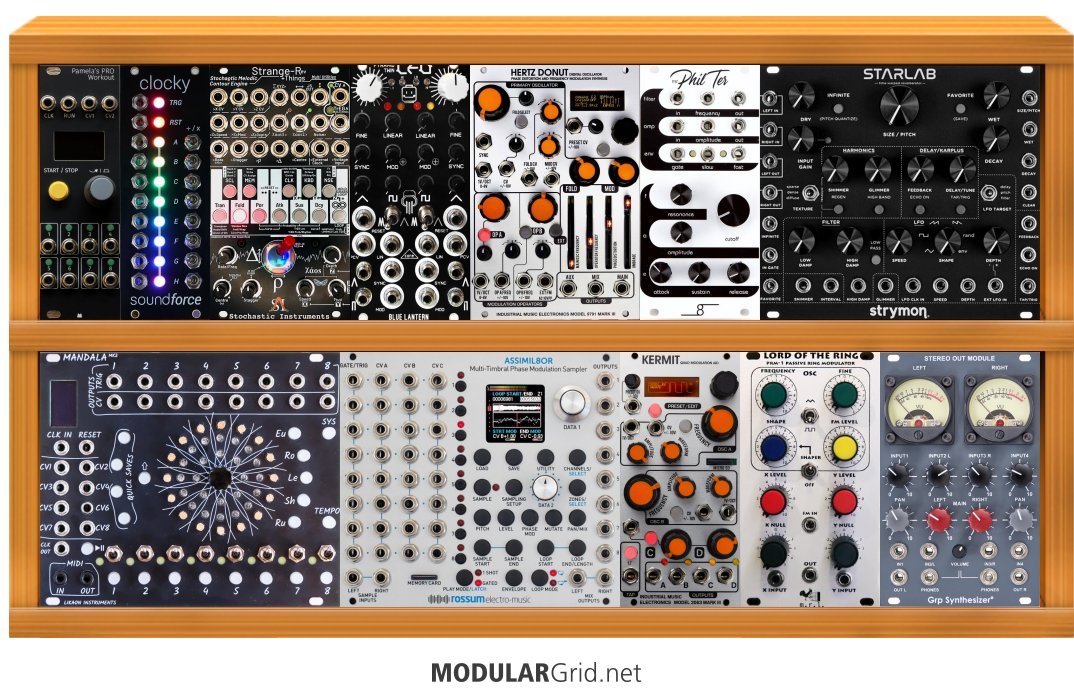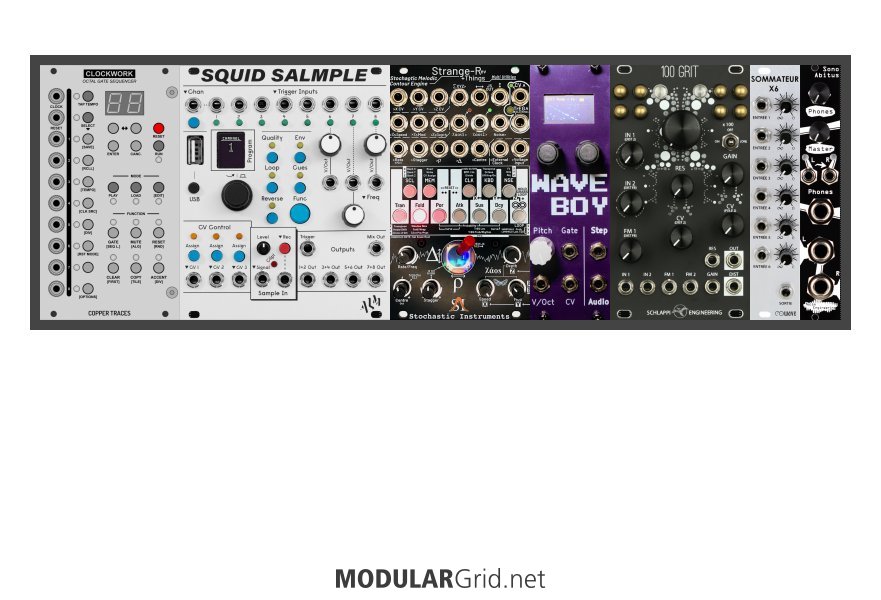fyi, the admins of this site, i just got claude 3.7 sonnet to generate a draft of this document, if yall want to work on it further and put it on a special page, etc. as follows:
...
...
...
Zen and the Art of Eurorack Modular Case Construction
There is an undeniable poetry in the hum of electronics, in the deliberate patching of cables, and in the slow dance of knobs being turned toward sonic revelation. The path of modular synthesis is not merely about creating sound—it is about creating yourself.
I remember my first case: a simple wooden box with aluminum rails, power supply hanging precariously from the back. I had no idea what I was doing. In truth, none of us do at first.
The Way of Modular Thinking
Modular synthesis is not merely a hobby; it is a philosophy. We seek not to play an instrument but to create one—to build a personal extension of our musical consciousness. The instrument becomes both map and territory, journey and destination.
When you decide to build a Eurorack case, you are making a commitment to a relationship that will evolve over years. Like any worthwhile relationship, it requires patience, understanding, and forgiveness—especially forgiveness.
Understanding the Fundamental Voices
Before we discuss construction, we must understand what we are constructing. These are the voices that will speak through your fingers:
Oscillator (VCO): The primary voice generator. It creates waveforms—sine, triangle, sawtooth, square, pulse—each with its own tonal character. This is where sound begins its journey.
Filter (VCF): The sculptor. It removes or emphasizes certain frequencies, carving the raw waveform into more complex shapes. Lowpass allows lower frequencies to pass while cutting higher ones. Highpass does the opposite. Bandpass allows only a band of frequencies through. Notch cuts a specific frequency band.
Amplifier (VCA): The gatekeeper. It controls the volume of your signal, allowing sounds to swell and fade. Without it, all sounds would be at constant volume—a crude existence indeed.
Envelope Generator (EG/ADSR): The shaper of time. Attack determines how quickly a sound rises to full volume. Decay sets how quickly it falls to the sustain level. Sustain is the volume held while a key is pressed. Release sets how quickly the sound fades after release.
Low Frequency Oscillator (LFO): The animator. It creates cycling control signals too slow to be heard as pitch, used to modulate other parameters over time—creating vibrato, tremolo, or rhythmic pulsing.
Sequencer: The storyteller. It sends a series of predetermined voltages to other modules, creating repeating patterns of notes or parameter changes.
Noise Generator: The whisperer of chaos. It creates unpredictable signals across the frequency spectrum—white noise contains all frequencies at equal energy; pink noise emphasizes lower frequencies.
Sample & Hold: The randomizer. It takes an input signal and freezes its value until triggered again, often creating stepped random patterns when fed noise.
Attenuator/Attenuverter: The diplomat. It reduces the strength of signals (attenuation) or can also invert them (attenuversion), allowing for subtlety in modulation.
Mixer: The unifier. It combines multiple signals into one output, allowing layered sounds to travel together.
Clock: The heartbeat. It generates regular timing pulses that synchronize various modules in rhythmic harmony.
The Five Common Patch Structures
1. The Classic Monophonic Voice
VCO → VCF → VCA
↑ ↑
| |
└ EG1 └ EG2
The fundamental patch. An oscillator's waveform passes through a filter, then an amplifier. One envelope controls the filter's cutoff frequency, opening and closing it over time. Another envelope controls the amplifier, shaping the volume contour. A keyboard or sequencer typically controls the oscillator's pitch.
2. The Self-Generating Ambient System
Noise → S&H → Quantizer → VCO → VCF → VCA → Reverb
↑ ↑ ↑ ↑ ↑
| | | | |
└ LFO1 └ Clock → Divider → LFO2 └ LFO3 └ EG
Here, randomness becomes structure. Noise fed into a Sample & Hold creates random voltages that are quantized to musical scales. These control an oscillator's pitch while LFOs modulate timbre and spatial characteristics. A clock keeps everything in loose synchronization, creating evolving ambient textures that can run without human intervention.
3. The Rhythmic Percussion Network
Clock → Sequential Switch
↓ ↓
Triggers → Envelope Generators → VCAs → Noise/Oscillators → Filters → Mixer
↓ ↓
LFOs → Modulation Destinations Output
A clock drives a sequential switch that distributes triggers to different envelope generators. These shape noise or oscillators through VCAs to create various percussive elements. LFOs modulate parameters for variation, and everything mixes together for complex rhythmic patterns.
4. The Dual Oscillator Complex Voice
VCO1 → Wavefolder → Mixer → VCF → VCA → Output
VCO2 → Ring Mod → ↑ ↑ ↑
↑ | |
└── LFO ──────────────────┘ |
└── EG ───────────────────────┘
Two oscillators create rich harmonic content, one through wavefolding (creating harmonics through folding a waveform back on itself), the other through ring modulation (multiplying signals to create sum and difference frequencies). These are mixed, filtered, and amplified together, with modulation creating movement and expression.
5. The West Coast Exploration
Complex Oscillator → Waveshaper → Low Pass Gate → Output
↑ ↑ ↑
| | |
Function Generator → Attenuverters → Pressure Points
Inspired by Buchla's approach, this patch uses complex oscillators with built-in wavefolding and modulation, further shaped by waveshapers. Instead of a filter and VCA, a Low Pass Gate combines both functions, responding to pressure control for expressive playing. Function generators create complex envelope shapes beyond the standard ADSR.
Common Mistakes in the Path of Modular
In Module Selection
The Allure of Complexity: Beginners often choose modules with the most knobs, jacks, and functions, but simplicity often leads to greater mastery. Start with fundamental modules that do one thing well.
Neglecting Utilities: Mixing, attenuation, and signal routing are not glamorous but are essential. Without them, your beautiful voices have nowhere to go.
Insufficient Modulation Sources: A system with many sound sources but few modulation sources is like a body without a nervous system. LFOs, envelopes, and random sources bring life to static sounds.
Improper Sizing: Choose modules that fit your case dimensions. HP (horizontal pitch) is precious—don't waste it with poor planning.
Forgetting Playability: We become so entranced with the idea of possibilities that we forget to make something playable. Include modules that respond to human touch and expression.
In Patching
Gain Staging Carelessness: Too much gain leads to distortion; too little disappears into noise. Pay attention to signal levels throughout your patch.
Modulation Extremes: Subtle modulation often creates more musical results than extreme settings. Learn to appreciate gentleness.
Ignoring Signal Flow: Understanding the path of voltage is crucial. Each cable tells a story—know where it begins and ends.
Cable Clutter: Organization leads to clarity of thought. Use different cable lengths and colors to maintain order in complexity.
The Single Patch Syndrome: Many never explore beyond their first successful patch. Remember that modular systems are about exploration—change is the only constant.
In Assembly
Power Supply Underestimation: The heart of your system deserves respect. Never skimp on power quality or capacity.
Insufficient Cooling: Electronics generate heat. Without proper ventilation, modules can fail prematurely.
Poor Grounding: Ground loops cause noise and can destroy modules. Ensure proper power distribution and grounding.
Overlooking Ergonomics: Frequently used modules should be easily accessible. Place them where your hands naturally fall.
Ignoring Depth Requirements: Some modules extend far behind the panel. Research physical dimensions before purchasing.
The True Motivations of the Modular Path
Why do we do this to ourselves? Why spend thousands on a system that could be replicated in software for a fraction of the cost? This question has haunted me through countless late nights of patching.
The truth is complex and deeply personal:
Tangibility in a Digital Age: We crave physical interaction with our tools. Turning a knob with your fingers connects you to sound creation in a way clicking a mouse never can.
The Promise of Discovery: Every patch contains the possibility of sounds you've never heard before—sounds that might never have existed until you connected those particular cables.
The Beauty of Limitations: Paradoxically, working within constraints often leads to greater creativity than having infinite options. The specific character of your modules shapes your musical voice.
The Meditative Process: Patching becomes a form of meditation—a focused attention on the present moment, on cause and effect, on the relationships between elements.
The Community: Modular synthesis connects you to others on similar journeys. We share patches, modules, and stories. We gather at synthesizer meet-ups to celebrate our shared obsession.
The Unfinished Symphony: A modular system is never complete. It evolves as you evolve. This perpetual becoming is perhaps its greatest gift.
Final Reflections
After years of building, patching, selling, regretting, and rebuilding, I've come to see my Eurorack case as a mirror reflecting my musical consciousness. Its strengths and weaknesses are mine. Its voice is my voice.
The path of modular synthesis teaches patience. It teaches acceptance of imperfection. It teaches that the journey itself is the destination.
When you build your case, remember that you are not merely assembling a musical instrument. You are creating a space for exploration, for failure, for discovery, and ultimately, for expression.
Approach this path with an open heart and steady hands. Listen more than you play. Question more than you conclude. And remember that the most profound sounds often emerge not from complexity, but from deep understanding of simplicity.
May your patches surprise you, and may your case always have room for one more module.


